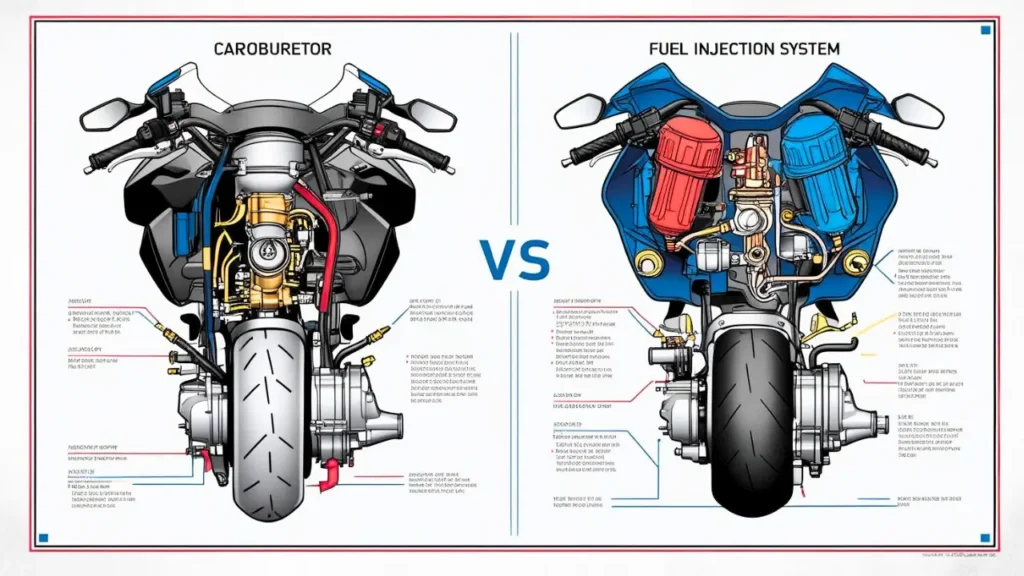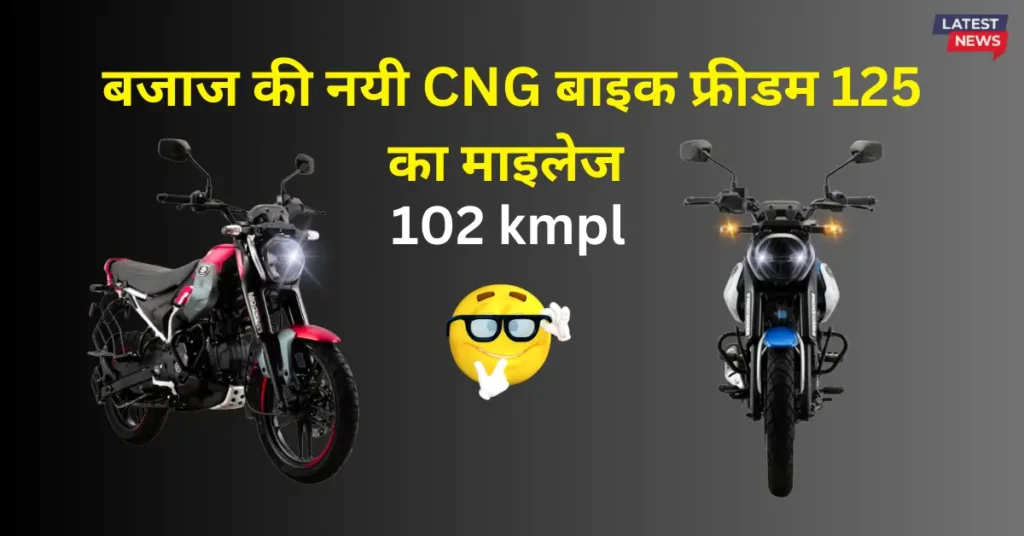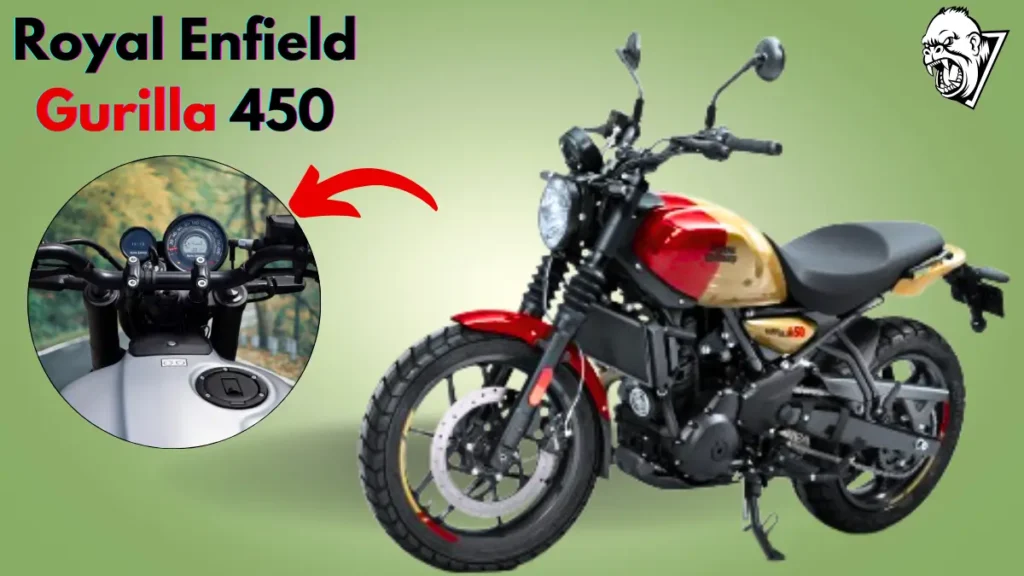Carburetor vs Fuel Injection: If you’ve ever been around bikes or cars, you’ve probably heard the terms “carburetor” and “fuel injection” thrown around. Maybe you’ve wondered what they mean, how they work, or which one is better. Well, you’re not alone, This is one of those topics that can get a bit technical, but don’t worry, I’ll break it down in a way that’s easy to understand. By the end of this article, you’ll know exactly what sets these two systems apart and which one might be the better choice for your bike.
Let’s Start with the Basics: What Do They Do?
Both carburetors and fuel injection systems have the same job like to mix air and fuel in the right proportions and deliver that mixture to the engine for combustion. This process is what powers your bike and keeps it running. But the way they do this is where the differences come in.
What is a Carburetor?
A carburetor is a mechanical device that’s been around for over a century. It’s a bit like a magic box that mixes air and fuel using simple physics, no electronics involved. Here’s how it works:
- Airflow: When you twist the throttle, it opens a valve that lets air flow into the carburetor.
- Fuel Mixing: As the air flows through, it creates a vacuum that sucks fuel from the fuel tank into the carburetor.
- Combustion: The air-fuel mixture is then sent to the engine, where it’s ignited to produce power.
Carburetors are pretty straightforward and have been used in bikes for decades. They’re reliable, easy to repair, and don’t require much fancy technology. However, they do have some limitations, which we’ll get into later.
What is Fuel Injection?
Fuel injection, on the other hand, is a more modern system. It uses electronic sensors and injectors to deliver fuel directly into the engine. Here’s how it works:
- Sensors: The system uses sensors to monitor things like engine temperature, air pressure, and throttle position.
- Fuel Delivery: Based on this data, the Electronic Control Unit (ECU) calculates the exact amount of fuel needed and sends it to the injectors.
- Combustion: The injectors spray the fuel directly into the engine’s combustion chamber, where it mixes with air and ignites.
Fuel injection is more precise and efficient than a carburetor, which is why it’s become the standard in most modern bikes.
Key Differences Between Carburetor and Fuel Injection: Carburetor vs Fuel Injection
Now that we’ve covered the basics, let’s dive into the key differences between these two systems. This is where things get interesting:

1. Performance (Carburetor vs Fuel Injection)
Carburetors are simple and work well in most conditions, but they’re not very precise. The air-fuel mixture can vary depending on factors like altitude, temperature, and humidity. This can lead to inconsistent performance, especially in extreme conditions.
Fuel injection systems are much more precise. They adjust the air-fuel mixture in real-time based on data from the sensors, ensuring optimal performance in all conditions. This means better throttle response, smoother acceleration, and more power.
2. Fuel Efficiency (Carburetor vs Fuel Injection)
Carburetors are less efficient because they can’t adjust the air-fuel mixture as accurately. This often leads to higher fuel consumption and more emissions.
Fuel injection systems are designed to deliver the exact amount of fuel needed, which improves fuel efficiency and reduces emissions. This is one of the reasons why fuel-injected bikes are more environmentally friendly.
3. Maintenance (Carburetor vs Fuel Injection)
Carburetors are relatively easy to repair and maintain. If something goes wrong, you can usually fix it with basic tools and some mechanical know-how. However, they do require regular cleaning and tuning to keep them working properly.
Fuel injection systems are more complex and require specialized tools and knowledge to repair. While they’re generally more reliable and require less maintenance, fixing them can be expensive if something goes wrong.
4. Cost (Carburetor vs Fuel Injection)
Carbureted bikes are usually cheaper to buy and maintain. The technology is older and simpler, which keeps costs down.
Fuel-injected bikes tend to be more expensive upfront because of the advanced technology involved. However, the long-term savings in fuel and maintenance can offset the initial cost.
5. Cold Starts (Carburetor vs. Fuel Injection)
Cold starts can be a bit of a hassle with carbureted bikes. You often need to use a choke to get the engine running, and it can take a while for the bike to warm up.
Fuel-injected bikes handle cold starts much better. The system automatically adjusts the air-fuel mixture, so you don’t need to use a choke. The engine starts smoothly, even in cold weather.
6. Altitude and Weather
Carburetors struggle with changes in altitude and weather. If you’re riding in the mountains or in extreme temperatures, you might notice a drop in performance.
Fuel injection systems adapt seamlessly to changes in altitude and weather. This makes them a better choice for riders who frequently travel to different climates or terrains.
Which One is Better for Your Bike?
So, now that we’ve compared the two, which one should you choose? Well, it depends on your needs and preferences. Here’s a quick breakdown to help you decide:

Choose a Carburetor If:
- You’re on a tight budget and want a cheaper bike.
- You prefer simplicity and don’t mind doing regular maintenance.
- You’re comfortable with basic repairs and tuning.
- You ride in areas with stable weather and altitude.
Choose Fuel Injection If:
- You want better performance, fuel efficiency, and reliability.
- You’re willing to pay a bit more for advanced technology.
- You ride in different climates or terrains and need a bike that can adapt.
- You want a smoother, more modern riding experience.
Can I Convert My Carbureted Bike to Fuel Injection?
Yes, you can convert a carbureted bike to fuel injection, but it’s not a simple or cheap process. Here’s what you need to know:
What’s Involved in the Conversion?
- Fuel Injection Kit: You’ll need a complete fuel injection kit, which includes injectors, sensors, an Electronic Control Unit (ECU), and a fuel pump.
- Fuel Tank Modifications: Most carbureted bikes don’t have a fuel pump, so you may need to modify the fuel tank or add an external pump.
- Wiring and Sensors: Fuel injection relies on sensors (like oxygen, throttle position, and temperature sensors) and a wiring harness to connect everything.
- Tuning the ECU: The ECU needs to be programmed to work with your bike’s engine, which requires expertise and specialized tools.
Is It Worth It?
Pros:
- Improved fuel efficiency and performance.
- Better throttle response and smoother rides.
- Easier cold starts and adaptability to altitude/weather changes.
Cons:
- Cost: The conversion can be expensive, often costing more than buying a fuel-injected bike.
- Complexity: It requires technical knowledge and skills.
- Time-Consuming: The process can take days or even weeks.
Should You Do It?
If you’re attached to your bike and want modern performance, it’s possible. However, for most riders, it’s more practical to sell the carbureted bike and buy a fuel-injected model. Some aftermarket companies offer bolt-on fuel injection kits for specific bike models, which can simplify the process. Research thoroughly before deciding!
The Future of Carburetors and Fuel Injection
It’s no secret that fuel injection is becoming the standard in the motorcycle industry. With stricter emissions regulations and the demand for better performance and efficiency, carburetors are slowly being phased out. However, they’re still widely used in older bikes and some entry-level models, especially in developing countries where cost is a major factor.
That said, carburetors have a certain charm that appeals to classic bike enthusiasts. There’s something satisfying about the mechanical simplicity of a carburetor, and many riders enjoy the hands-on experience of tuning and maintaining them.
Conclusion
At the end of the day, both carburetors and fuel injection systems have their pros and cons. It all comes down to what you value most in a bike. If you’re looking for something affordable and easy to work on, a carbureted bike might be the way to go. But if you want the latest technology, better performance, and lower maintenance, fuel injection is the clear winner.
Which is more fuel-efficient carburetor or fuel injection?
Fuel injection is more fuel-efficient because it adjusts the air-fuel mixture in real-time, ensuring optimal combustion and reducing waste.
Are carbureted bikes cheaper than fuel-injected bikes?
Yes, carbureted bikes are generally cheaper to buy and maintain because the technology is simpler and older.
Why are carburetors still used in some bikes?
Carburetors are cheaper and easier to repair, making them popular in entry-level bikes and regions where cost is a major factor.
Does fuel injection work better at high altitudes?
Yes, fuel injection adapts seamlessly to changes in altitude and weather, while carburetors struggle with these conditions.

